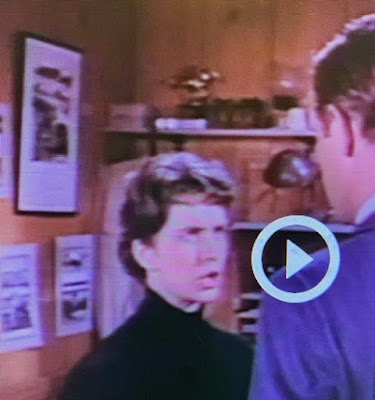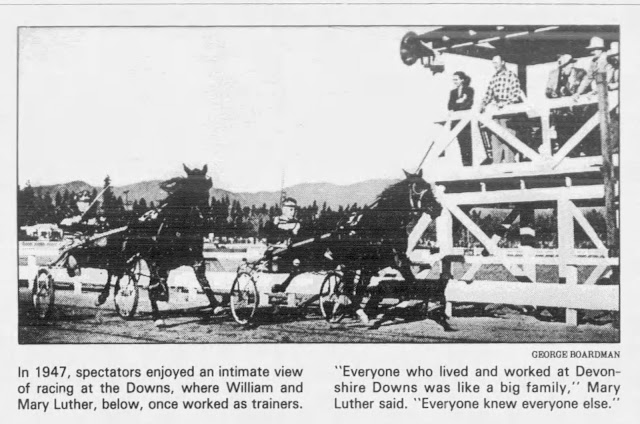 |
| Swaps on the cover of Sports Illustrated magazine |
Horse history lovers remember the California-bred chestnut Thoroughbred stallion Swaps (chestnut horse, foaled 1952, Khaled [Great Britain] x Iron Reward) as the winner of the 1955 Kentucky Derby (over the heavily favored Nashua), the Santa Anita Derby, the Hollywood Gold Cup Stakes, and many more races. He has been called "California's most famous Thoroughbred."
The National Museum of Racing and Hall of Fame website summarizes his career. It begins:
Swaps was so fast that he set a world record for a mile, a world record for a mile and 70 yards, a world record for 1 1/16 miles (and broke that one), equaled an American record for 1 3/16 miles on turf, set a world record for 1 5/8 miles, and raced to three other track records — 10 in all — yet owner/breeder Rex Ellsworth said he never fully turned Swaps loose to see how fast he could run.
Bred in California, Swaps won three of his six starts as a juvenile and finished second in two others before emerging as a 3-year-old superstar in 1955. He began the year with victories in the San Vicente Stakes and Santa Anita Derby before defeating Nashua in the Kentucky Derby. Swaps then returned to California to win the Will Rogers, Californian, and Westerner stakes.
In August, Swaps tried the grass for the first time, winning the American Derby at Washington Park. He gave seven pounds to Traffic Judge and beat him by a length in 1:54 3/5 to equal the American record for 1 3/16 miles on turf.
Eleven days later, Swaps met Nashua in a match race at Washington Park. Swaps was not in his best form and was defeated by 6 1/2 lengths. It was his final race of the year....
There's more to his story. We'll look at that shortly.
We remember Swaps in many ways. There are many famous photographs of him. Swaps appears in this montage of California Thoroughbreds that author and artist Gladys Brown Edwards saved:
 |
| This photo of Swaps appeared in Western Horseman magazine. |
 |
| Another old magazine carried this photo of Swaps and Shoemaker. |
Sculptor Albert Stewart created a bronze statue of Swaps and jockey William Shoemaker, based on a design and setting by Millard Sheets. It stood at Hollywood Park from 1958 until the facility (which had closed in 2013) was demolished in 2015. The statue is reportedly being stored until it can be relocated elsewhere.
The Southern California pottery Hagen-Renaker, Inc. captured Swaps in two different ceramic designs by artist Maureen Love.
 |
| Hagen-Renaker's miniature and larger "Swaps" ceramic figurines in front of a photo print of the real Swaps. Photo by author. |
The larger Designers Workshop "Swaps" was first issued in 1957, and the miniature in 1959. Both molds were leased by Breyer and issued in plastic; its Classic "Swaps" was first issued in 1975, and the smaller Stablemate "Swaps" in 1976.
 |
| Closeup of the author's DW Hagen-Renaker "Swaps" |
We're fortunate that Swaps raced in the age of film, because he can be seen in action in a number of newsreels and documentaries that have survived online. I'll put some links to these at the end of this post.
But there was more to Swaps' film career than documentaries and horse racing newsreels. Swaps is listed as an uncredited cast member in the 1956 RKO Studios feature film "Glory."
Part Girl-Meets-Horse film, part musical, "Glory" starred Margaret O'Brien in her first "grown-up" role. O'Brien is considered by many to have been the best "child star" of Hollywood's golden era. When she was six years old, she played Judy Garland's little sister Tootie in the 1944 classic "Meet Me in St. Louis," for which she received a special Academy Award for best child actress.
 |
| Margaret O'Brien and Judy Garland in "Meet Me in St. Louis." Source: Wikipedia |
In "Glory," O'Brien's co-stars included Hollywood stalwarts Walter Brennan and Charlotte Greenwood. O'Brien's character falls in love with a Thoroughbred filly called Glory, who (in the story) went on to win the Kentucky Derby.
"Glory" began with commentary on Thoroughbred horse racing, including mentions of Fair Play, Mahmoud, Alibhai, Citation, and Bull Lea. Swaps gets a mention as having been in "Glory" because the film contains actual footage of him -- as the fictional horse Glory -- winning the 1955 Kentucky Derby.
The fictional Glory was also played by at least two unnamed Thoroughbreds. The foal in the photo below played the title role early in the film. The caption under this photo in a local newspaper mentions that "many scenes in the picture were filmed at Calumet Farm, Keeneland Race Course and other locations in Fayette County."
 |
| Lexington Herald-Leader, January 5, 1956 |
Other newspaper accounts say that the birth of the filly was actually filmed in California. As soon as foaling was complete, the mare and her offspring were trucked to the RKO Studio in Hollywood for two days of filming with their human co-stars.
 |
| Greensboro, NC News and Record, July 31, 1955 |
Glory the adult movie horse was chestnut like Swaps -- although of course Swaps was not female. We can see an unknown horse that played the title role in "Glory," in this screen grab of a picture from Allen Ellenberger's 2000 biography Margaret O'Brien. This horse looks slightly roman-nosed.
Since the film of Swaps winning the Kentucky Derby was used in "Glory," it was important that the horses that played the part of Glory in closeup shots have similar color and markings. It's not uncommon for movie horses to have white markings added or removed for their film roles.
Here's a publicity still from "Glory" showing Margaret O'Brien with a horse. Look at the size and shape of the star on its forehead. This horse also appears to have a snip near its right nostril. The makeup artist (if that's what you call the person who adds or removes white markings from movie horses) was attempting to replicate Swaps' facial markings.
We also see the movie horse Glory in a film clip archived on YouTube. (I'll put a link to it at the end of this post.) The star on the horse in this sequence appears to be different than the one in the photo above.
Compare the stars on Movie-Glory's forehead with the real Swaps' smaller star marking. This photo from the cover of the July 18, 1955 issue of Sports Illustrated also shows his white snip.
But, considering that we see the real Swaps from a distance in the '55 Derby footage in the film, perhaps these errors on the part of pre-CGI Hollywood horse makeup artists can be forgiven.
TCM has archived the original trailer for "Glory" on its website.
https://www.tcm.com/video/143279/glory-1956-original-trailer/
Horse Figurine Sidebar: Look at this screen grab from the trailer. See the trophy above Margaret O'Brien's head?
It appears to be a Dodge. Inc./Gladys Brown Edwards Thoroughbred and jockey trophy! I don't own one, but my friend Vickie was kind enough to loan me a photo of hers. This example of the trophy top is mounted on a piece of marble or onyx.
Back to the main story: Even though the exterior scenes in "Glory" were filmed at historic locations in Kentucky, much of the movie was shot in California. TCM notes that the San Fernando Valley ranch of film director Rowland V. Lee was used; the Internet Movie DataBase website and contemporary newspaper accounts say that the RKO Studios in Hollywood were also used.
 |
| Los Angeles Mirror, January 12, 1956 |
 |
Ellenberger's biography quotes O'Brien about her meeting with Swaps:
While I was making "Glory" we were out at Hollywood Park, and they let me ride Swaps. He was very gentle --not too high strung like so many race horses. You could get hold of him and he wouldn't go too fast if you didn't want him to.
Calling her "quite a skilled equestrienne," columnist Tommy Fitzgerald said that O'Brien rode Swaps bareback, which is backed up by this publicity still. O'Brien is wearing the same cap and clothing as in the magazine cover photo above.
The 1955 relationship between Margaret O'Brien and Swaps went a step further. A syndicated news story reported that O'Brien would act as Swaps' mascot in his $100,000 match race against Nashua in Chicago.
 |
| (San Fernando) Valley Times, August 6, 1955 She didn't bring Swaps any luck. He did not have a good race, and lost that one to Nashua. But the defeat was far from the end of Swaps' story. His NRMHF website biography concludes: ...As a 4-year-old, Swaps was recognized as Horse of the Year and Champion Handicap Male. He won eight of his 10 starts and carried 130 pounds seven times. His wins included the Los Angeles County Fair, Broward, Argonaut, Inglewood, American, Hollywood Gold Cup, Sunset, and Washington Park handicaps. Swaps set a world record for one mile in the Argonaut (1:33 1/5), a world record for 1 1/16 miles in the Inglewood (1:39), and matched the world record for nine furlongs in the American Handicap (1:46 4/5). His time for the 1 1/4-mile Hollywood Gold Cup was 1:58 3/5, a track record that missed the world mark by two-fifths of a second. In the Sunset, at 1 5/8 miles, Swaps shattered the world mark with a clocking of 2:38 1/5. Swaps fractured a cannon bone while training that October and was retired with a career record of 19-2-2 from 25 starts and earnings of $848,900. Ellsworth had sold a half-interest in Swaps to John Galbreath for $1 million during the 1956 season and later sold the other half for a like amount. Swaps was sent to Darby Dan Farm in Kentucky for stud duty, later relocating to Spendthrift Farm. Swaps sired 35 stakes winners, including Hall of Fame member Affectionately. Swaps died in 1972 at the age of 20. |
During his career, Swaps touched the lives of millions of people all over the world. He, and Hollywood Park, are now gone. We occasionally see "Glory" on cable television. As of the publication of this post in July 2024, Margaret O'Brien is still with us. She continued acting until 2018. She has two stars on the Hollywood Walk of Fame -- one for her work in film, one for television. It's good to know that she also liked horses, and especially that Swaps, the world-famous winner of the Kentucky Derby and so many more races, was also gentle enough for her to ride.
***
.jpg)







a.jpg)




























